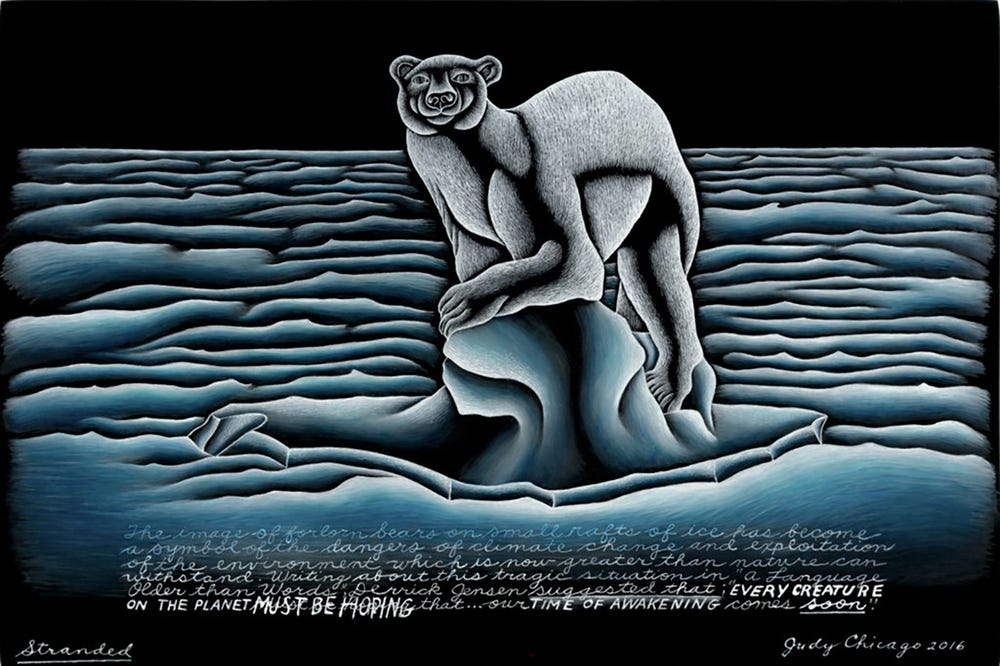de Youngsters Studio: Signs of Spring
By Hannah Freeman, senior teaching artist
March 19, 2021
Inspired by the stained glass Iris, Lily and Cattail Window (ca. 1904, attributed to Lederle and Geisler), you are invited to create a simple composition to hang in your window, with a focus on colors, shapes, and lines found in nature.
Materials
- Black or dark-colored 9 x 12 in. construction paper
- Ruler
- Pencil
- Eraser (optional)
- Scissors
- Several sheets of spare paper
- Black and various-color permanent markers; color crayons may also be used
- Gallon-size plastic baggie or any clear plastic bag or sheet protector; tracing/parchment paper may also be used
- Masking tape
- Glue stick
- Glue dots or clear tape
Questions to Consider
- What colors, shapes, and lines do you notice in the Iris, Lily and Cattail Window? Think about the signs of spring you see outside; what is your eye drawn to? Consider choosing one main object of focus for your window hanging. How can you represent it with simple shapes? What other colors, shapes, and lines from nature will bring contrast to fill your composition?
Steps
1. Fold your black construction paper in half, to make a 9 by 6 in. folded card. Fold in half again, to make a 4.5 by 6 in. folded card. Align the edge of the ruler along the three “open edges” of the card and draw a pencil line border using the width of your ruler (approx. 1 in. border.) With the folded 6 in. edge closest to you, use scissors to cut through the folded edge up to the pencil border line on both short sides, then along the top. Remove the cut out folded center piece, and unfold to reveal the border “frame” for the window hanging. If you like, you can fold back the construction paper frame so the pencil marks from drawing the border are unseen on the inside. Set aside.
2. The main focus object for your window hanging could be a flower, bug, or interesting leaf you’ve seen out on a walk. You could also look up images online. With some spare paper and a pencil, sketch some ideas and pick which you like best. Use your cut paper frame as a viewfinder to experiment with the orientation of your design. Once you have decided on the orientation, use a pencil to draw the frame’s inner rectangle on top of your drawing. (Alternately, you could start with the rectangle drawn on the paper to sketch within.) You may wish to use a color marker to draw over only the most essential pencil lines, to pare it down to a simple design.
3. Now think about how you can incorporate color. Test out some colors on the paper’s edge; we will save the coloring for the finished piece on our plastic “window.”
4. Cut along the edges of the plastic baggie. Lay the plastic sheet over your sketch and cut to have approximately half-inch margin overlap the edge of the drawn rectangle.
5. Stick the plastic corners to the paper sketch with masking tape, to keep it from shifting as you trace over the lines with black permanent marker. Tip: it can take a while for the permanent marker to dry; consider tracing the lines closest to you, then spin the paper and plastic as you work, so your hand isn’t smudging the wet marker.
6. Once the black marker is dry, unstick the taped corners and flip over onto a clean sheet of spare paper. Add more tape to the corners to keep the plastic stretched flat, ready for coloring. Pick colors that will contrast and complement one another. Tip: flipping the plastic over means you don’t have to worry about the black marker bleeding into lighter colors. Coloring on plastic can take more time than coloring on paper. Consider outlining the shape you’re coloring first, then filling in. Try making pen strokes in one direction, rather than back and forth.
7. Once you have finished coloring, you are ready to frame it! Open the frame and lay your work on the right, tape the corners, and along the edges to hold it in place. Carefully apply your glue stick on the inside left of the frame and close to stick shut. Use glue dots or small tape circles to display your work in a window!
Reflect
What window will you hang your work in and why? Artists often consider lighting and how their work is displayed as a major component of their work. How does the mood of your artwork change when it is displayed in a window? How does the time of day or weather affect how your artwork is viewed? Now that you’ve made one window hanging, what colors will you try next?
Share
Perhaps you could fill a window to display your Signs of Spring artwork to your neighbors! How can you illuminate your window hanging from inside, so it can be better seen from outside?
We would love to see what you create! Email pictures of your artwork to families@famsf.org or tag us on any social platform with #deyoungsters.


